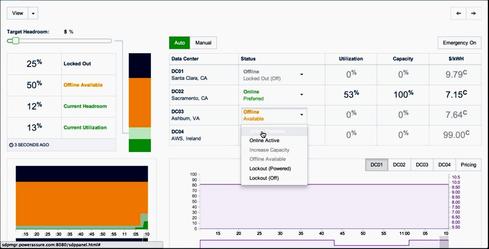Cutting Datacenter Power CostsCutting Datacenter Power Costs
Power management services and tools can cut consumption by swapping workloads between servers, but analysts say IT efficiency tools face challenges in the enterprise.
May 1, 2014

When the concept of load balancing was first presented to datacenters, it was with the notion of consolidating processor use and increasing availability. When cloud dynamics changed the schematics of datacenters, it became clear to some that load balancing achieves an even higher goal: power reduction.
With its latest datacenter monitoring service, EM/5, Power Assure’s goal is not so much to use load balancing to maximize or concentrate utilization as it is to simply turn stuff off when it’s not being used. The sad fact of datacenter power strategies today is that too many servers are just sitting there, waiting for something to do, spinning their wheels, and consuming kilowatt-hours in the process. Power Assure calls what it does to address this problem "software-defined power."
In a live demonstration given by Power Assure to Network Computing, a test enterprise network comprising three datacenters, backed up by Amazon AWS, was suddenly hit with a heavy workload. Web servers in datacenters in Sacramento and Santa Clara, Calif., and Ashburn, Va., were ramped up from under 10,000 transactions per second to well over 100,000. At the beginning of the test, the entire workload was handled by five servers in the Sacramento rack. As the EM/5 dashboard indicated, Sacramento was chosen because it was supplied with the least expensive electricity at that moment.
Figure 1: 
When the workload started to ramp up, EM/5 indicated the first signs of stress. To remediate that stress without affecting the transaction flow, EM/5 instigated a live migration of the entire workload to the Ashburn rack. There, the power was slightly more expensive, but the servers could alleviate the bottlenecks.
Pete Malcolm, president and CEO of Power Assure, said EM/5 will enable datacenter managers to make rapid analyses of how much savings they could reap immediately by moving workloads, as well as how much more savings they could reap down the road by changing out existing servers for newer models.
With this level of power consumption analysis on hand, Malcolm told us, admins can experiment with the effects of swapping workloads among server models, server racks, and server centers. Next, a completely new opportunity may arise: purchasing electricity in bulk, in advance, on the wholesale market.
The strategy here is for managers to learn their applications’ power consumption patterns and, instead of powering up enough servers redundantly to account for any overage, power down those servers they’re less likely to need. Enterprises could spend from 20% to 40% less per kilowatt-hour this way, plus they would be consuming less kWh anyway.
“More than that, we can actually adjust your consumption by moving workloads around. So if we know you’ve purchased a certain amount of power on the day-ahead market and you’re getting close to that limit, we can move loads somewhere else so you don’t go over it," Malcolm said.
Matt Stansberry, director of content for the Uptime Institute research firm, told us there are two main problems holding back IT efficiency tools such as EM/5.
“The first is risk aversion: In a complex, heterogeneous IT environment, moving and restarting IT services can have an impact on application availability," he said. "The second, and more important issue, is that IT departments are not incentivized to undertake the efforts to improve efficiency.”
As Stansberry explained, the part of an organization that usually pays the power bill -- as much as four-fifths of the time -- is the facilities manager or corporate real estate manager. Since IT isn’t rewarded for how much the company saves on its electric bill, power-saving tools and services, which have existed in some form for several years now, don’t find their toehold.
“The majority of the datacenter efficiency discussion over the past seven years has been around PUE [power usage effectiveness],” Stansberry said. “But datacenter facilities teams and designers have done their jobs, and the infrastructure is dramatically improved. In fact, we’re at the point of diminishing returns on this issue. IT practitioners need to take the next steps and be incentivized to do it.”
Jennifer Koppy, IDC’s research manager for datacenter trends and strategies, who profiled Power Assure for IDC last year, said the power saving problem will only get worse, as datacenters keep adding new equipment.
“The pressure on datacenters will become much more acute in the next couple of years,” she said. “Management of these resources continues to be a problem, and although many management tools are on the market, they require a very thoughtful, committed approach that the entire organization is in on. So it takes a process change, and it takes a tool that people can trust to provide a single version of the truth.”
About the Author
You May Also Like




